Norway Renewable Energy Market Size
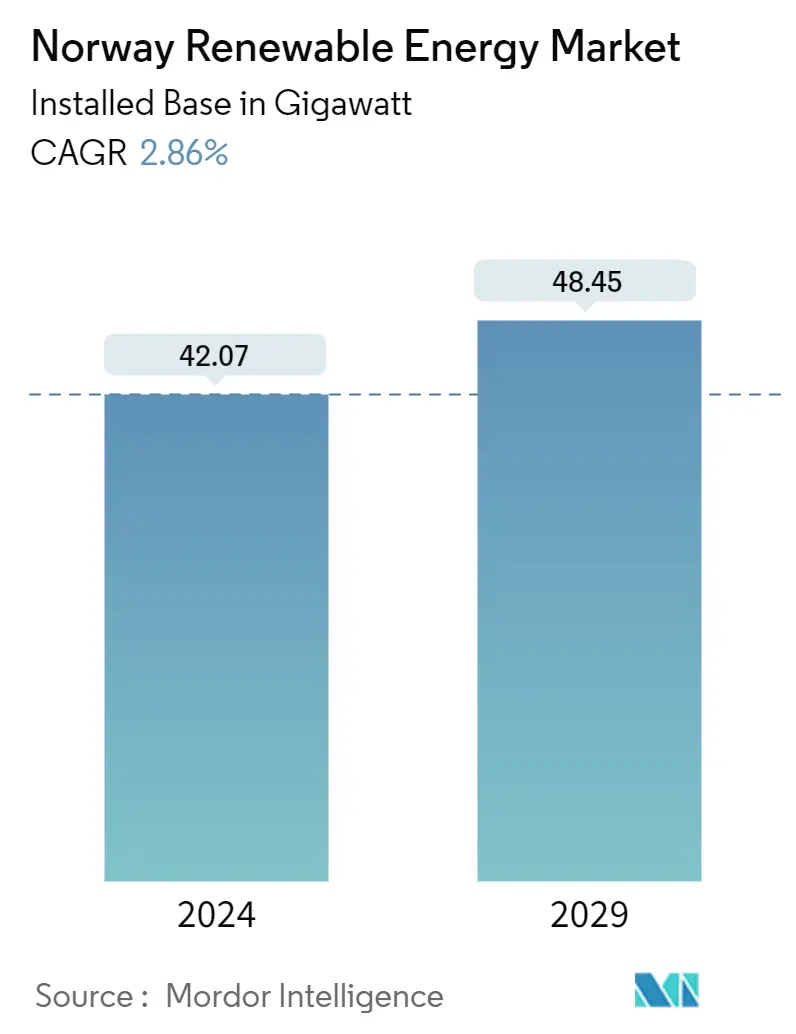
| Study Period | 2019-2029 |
| Base Year For Estimation | 2023 |
| Forecast Data Period | 2024 - 2029 |
| Historical Data Period | 2019 - 2022 |
| CAGR (2024 - 2029) | 2.86 % |
| Market Concentration | Low |
Major Players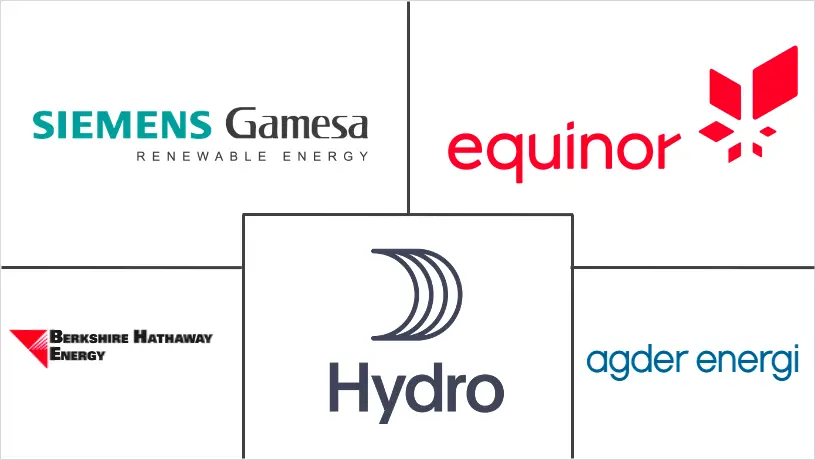
*Disclaimer: Major Players sorted in no particular order |
Norway Renewable Energy Market Analysis
The Norway Renewable Energy Market size in terms of installed base is expected to grow from 42.07 gigawatt in 2024 to 48.45 gigawatt by 2029, at a CAGR of 2.86% during the forecast period (2024-2029).
Over the long term, favorable government policies and regulations, coupled with technological advancements in renewable energy technology, are expected to drive the market during the forecast period.
On the other hand, the intermittent nature of renewable energy will likely hinder market growth.
Nevertheless, the penetration of the hydrogen economy in the region is expected to create significant opportunities for market studies during the forecasted period.
Norway Renewable Energy Market Trends
Hydropower to Dominate the Market
- Norway's rugged terrain and numerous rivers provide a natural advantage for harnessing hydropower, making it a reliable and efficient renewable energy source. Hydropower's long-established presence in Norway's energy mix underscores its role as a nation's power generation cornerstone.
- Moreover, hydropower aligns seamlessly with Norway's commitment to sustainability and carbon neutrality. The intermittent nature of wind and solar energy sources can be offset by the stability and predictability of hydropower, enhancing grid stability and enabling a consistent power supply. Norway's national climate goals are intertwined with expanding hydropower capacity, emphasizing its role in achieving energy security while reducing greenhouse gas emissions.
- According to the International Renewable Energy Agency, in 2022, the cumulative installed hydropower capacity in the region was 34.11 GW compared to 34.07 GW in 2021, registering a growth rate of more than 1%. Although the growth rate has been meager in recent years, it is expected to improve in the coming years due to the nation's target of reducing carbon emissions.
- For instance, in June 2023, GE Vernova announced that the company had secured an upgrade project for the Aurland-1 Hydropower Plant in Norway. The company will replace the existing rotor poles, which is expected to increase the efficiency of the power plant by 20-30%. The project will be carried out from 2025-2027.
- Furthermore, the nation's extensive hydropower infrastructure offers a competitive advantage. Norway's experience in engineering, operation, and maintenance of hydropower facilities positions it as a global leader. This expertise ensures efficient operations and drives innovation in areas such as pumped storage, enabling the integration of variable renewable sources.
- In conclusion, the envisaged dominance of hydropower within the Norway renewable energy market is firmly grounded in abundant water resources, sustainability imperatives, and technological proficiency. As Norway navigates the complexities of a renewable energy transition, the expansion of hydropower emerges as a transformative force, poised to redefine energy generation, enhance grid resilience, and contribute significantly to the nation's journey towards a sustainable and carbon-neutral future.
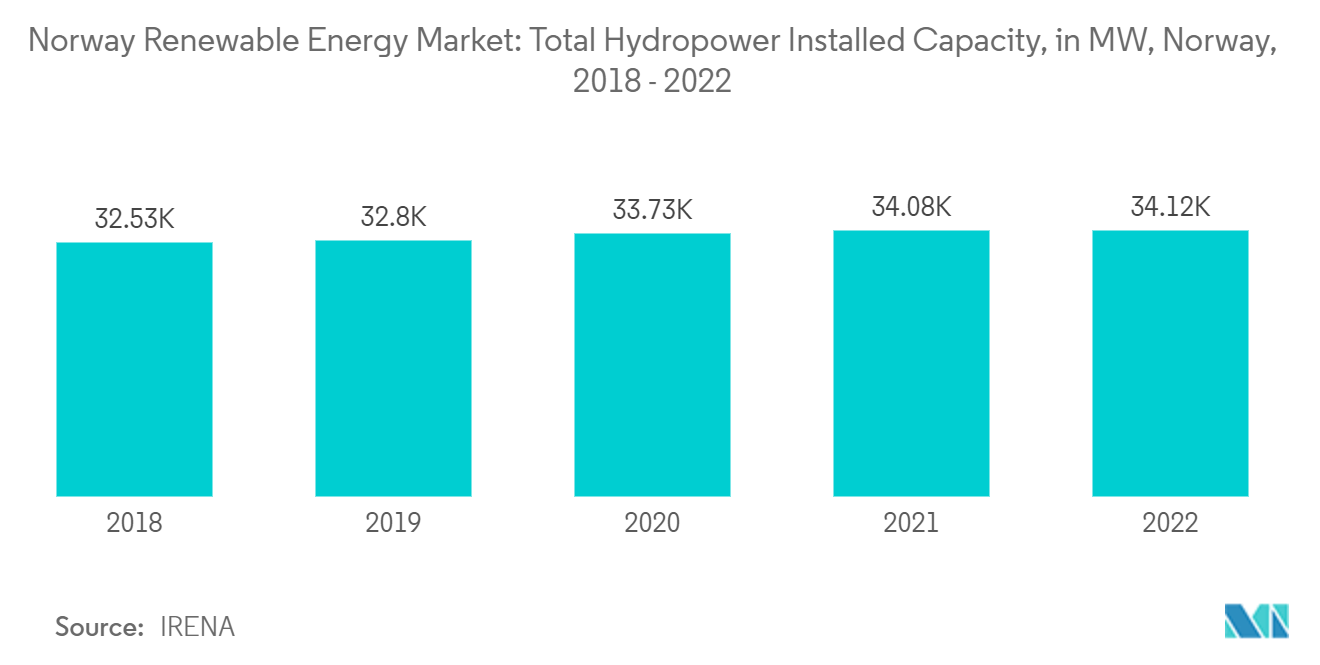
Supportive Government Policies to Drive the Market
- Strategic policy frameworks, incentives, and financial mechanisms are designed to promote renewable energy adoption, foster innovation, and facilitate investments. The alignment of policy initiatives with national climate goals underscores the critical role of government in creating an enabling environment for renewable energy growth.
- Moreover, the stability and predictability offered by supportive policies bolster investor confidence. Clear regulations, feed-in tariffs, and guaranteed purchase agreements provide a reassuring backdrop for renewable energy projects, attracting domestic and international investments. This predictability mitigates risks and encourages the expansion of renewable energy capacities across various sectors.
- For instance, in July 2023, the Norwegian government released The Offshore Energy Act Regulations, which allows operators to explore offshore regions in the country to deploy renewable energy sources such as wind energy. This is expected to increase the renewable energy capacity during the forecasted period.
- Furthermore, government policies drive technology advancement and research in the renewable energy sector. Research grants, innovation funds, and collaborative initiatives between the public and private sectors foster the development of cutting-edge technologies, enhancing the competitiveness of renewable solutions in the energy landscape.
- According to the International Renewable Energy Agency 2022, the country's cumulative renewable energy installed capacity was 39,650 MW in 2022 compared to 39,406 MW in 2021, registering a growth rate of almost 0.7%. However, the growth rate is expected to increase during the forecasted period due to government policies to increase renewable energy in the country.
- In conclusion, the anticipated role of supportive government policies in propelling the Norway renewable energy market is deeply rooted in sustainable objectives, investor confidence, and technological progress. As Norway navigates the complexities of energy transition, government policies emerge as a transformative force, poised to redefine energy consumption patterns, attract investments, and significantly contribute to the nation's journey towards a greener and more resilient energy future.
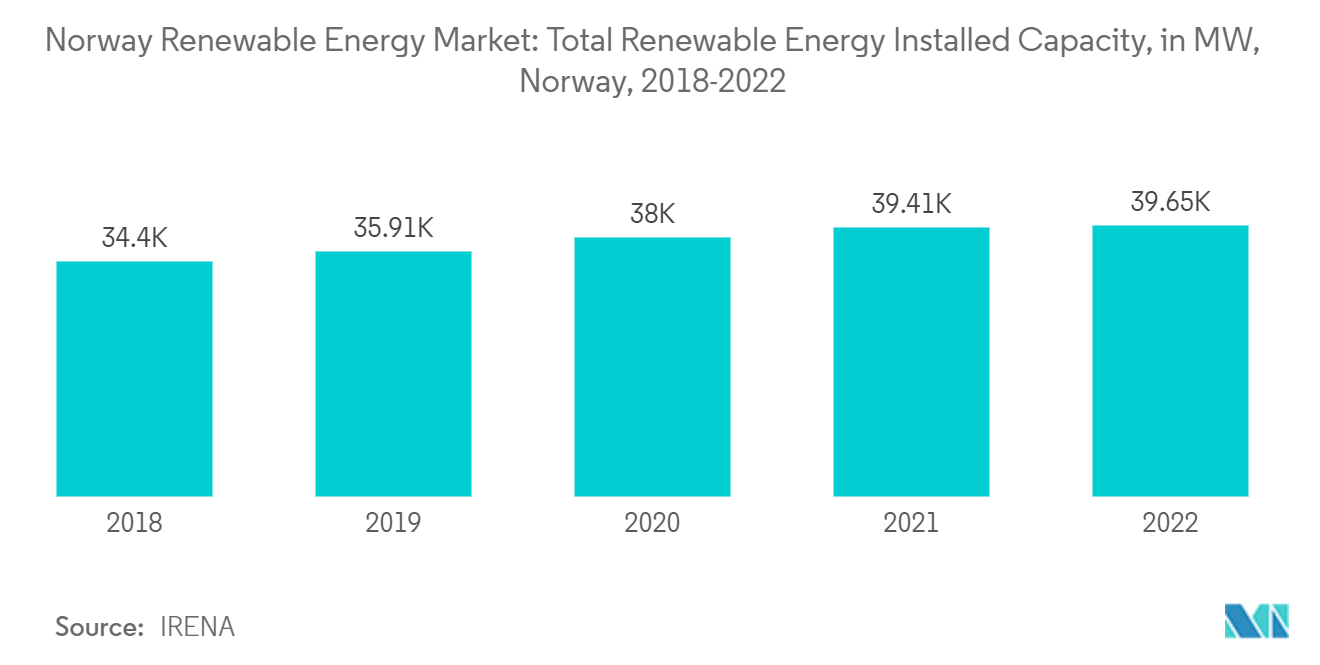
Norway Renewable Energy Industry Overview
The Norway renewable energy market is fragmented. Some of the key players in the market (in no particular order) include Norsk Hydro ASA, Agder Energi AS, Siemens Gamesa Renewable Energy SA, Equinor ASA, and Berkshire Hathaway Energy Co., among others.
Norway Renewable Energy Market Leaders
-
Norsk Hydro ASA
-
Agder Energi AS
-
Equinor ASA
-
Berkshire Hathaway Energy Co
-
Siemens Gamesa Renewable Energy S.A.,
*Disclaimer: Major Players sorted in no particular order
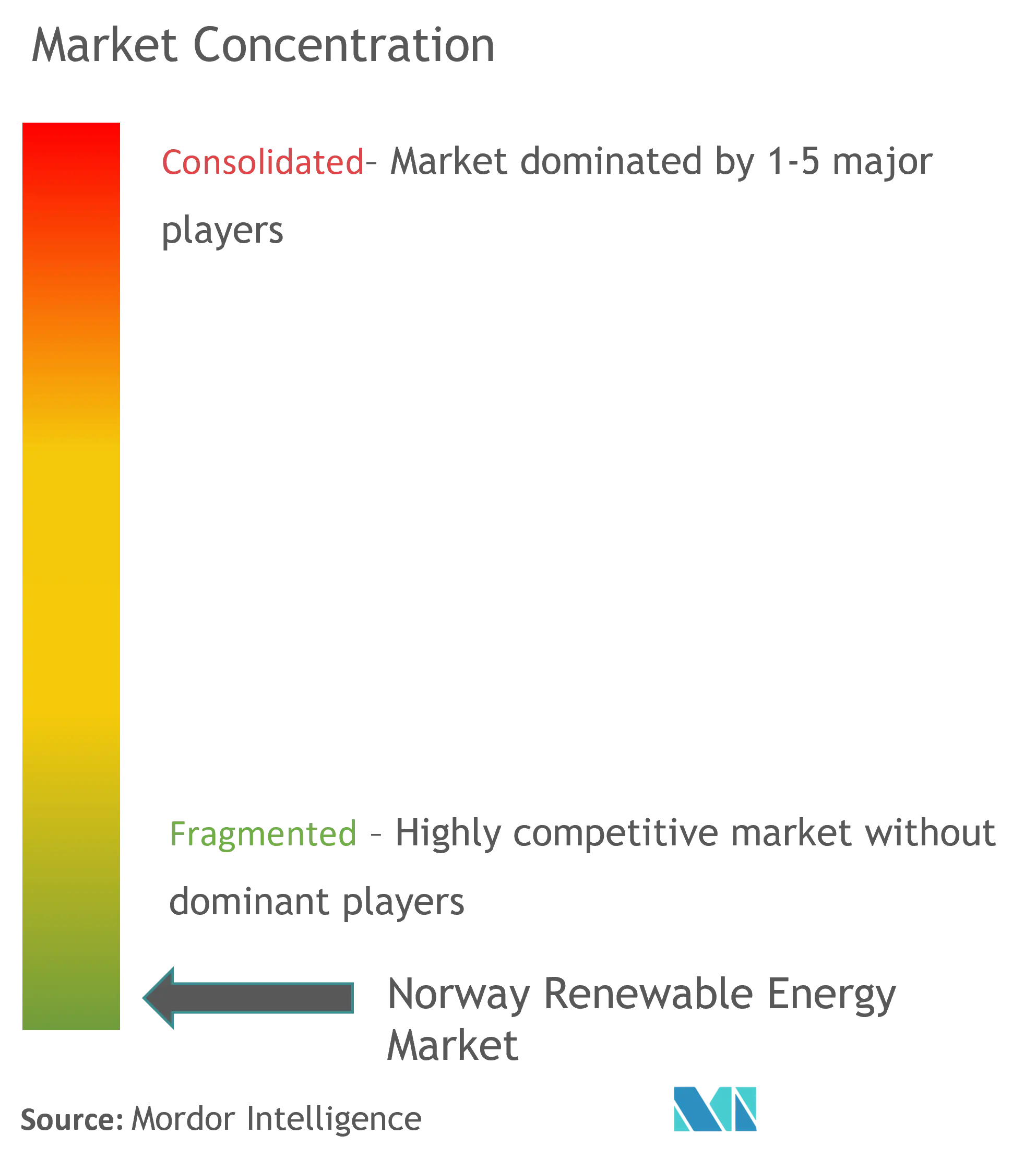
Norway Renewable Energy Market News
- June 2023: The Norwegian government has mandated all government offices to deploy solar panels from 2024. Later, in 2024, the government is expected to mandate all the large-scale commercial buildings in the country to deploy solar panels to generate electricity to reduce carbon emissions.
- November 2022: Norwegian company Equinor announced that the company decided to double its investments in the renewable energy sector in order to increase renewable energy penetration in the country.
Norway Renewable Energy Market Report - Table of Contents
1. INTRODUCTION
- 1.1 Scope of the Study
- 1.2 Market Definition
- 1.3 Study Assumptions
2. RESEARCH METHODOLOGY
3. EXECUTIVE SUMMARY
4. MARKET OVERVIEW
- 4.1 Introduction
- 4.2 Renewable Energy Installed Capacity and Forecast in GW, till 2029
- 4.3 Recent Trends and Developments
- 4.4 Government Policies and Regulations
-
4.5 Market Dynamics
- 4.5.1 Drivers
- 4.5.1.1 Supportive Government Policies
- 4.5.1.2 Technological Innovation in Renewable Energy
- 4.5.2 Restraints
- 4.5.2.1 Intermittent Nature of Renewable Energy
- 4.6 Supply Chain Analysis
- 4.7 PESTLE Analysis
5. MARKET SEGMENTATION
-
5.1 Source Type
- 5.1.1 Wind
- 5.1.2 Hydro
- 5.1.3 Other Source Types (Solar and Bioenergy)
6. COMPETITIVE LANDSCAPE
- 6.1 Mergers and Acquisitions, Joint Ventures, Collaborations, and Agreements
- 6.2 Strategies Adopted by Leading Players
-
6.3 Company Profiles
- 6.3.1 Norsk Hydro ASA
- 6.3.2 Agder Energi AS
- 6.3.3 Siemens Gamesa Renewable Energy SA
- 6.3.4 Equinor ASA
- 6.3.5 Berkshire Hathaway Energy Co.
- 6.3.6 Iberdrola SA
- 6.3.7 Suzlon Energy Limited
- 6.3.8 NextEra Energy Inc.
- *List Not Exhaustive
- 6.4 Market Ranking/Share Analysis
7. MARKET OPPORTUNITIES AND FUTURE TRENDS
- 7.1 Development of Hydrogen Economy
Norway Renewable Energy Industry Segmentation
Renewable energy refers to energy derived from natural resources that are replenished or regenerated over a relatively short period. These energy sources are considered sustainable and have minimal negative environmental impacts compared to non-renewable energy sources, such as fossil fuels.
Norway's renewable energy market is segmented by source. By source, the market is segmented into wind, hydropower, and others.
For each segment, the market sizing and forecasts have been done based on gigawatts (GW).
| Source Type | Wind |
| Hydro | |
| Other Source Types (Solar and Bioenergy) |
Norway Renewable Energy Market Research FAQs
How big is the Norway Renewable Energy Market?
The Norway Renewable Energy Market size is expected to reach 42.07 gigawatt in 2024 and grow at a CAGR of 2.86% to reach 48.45 gigawatt by 2029.
What is the current Norway Renewable Energy Market size?
In 2024, the Norway Renewable Energy Market size is expected to reach 42.07 gigawatt.
Who are the key players in Norway Renewable Energy Market?
Norsk Hydro ASA, Agder Energi AS, Equinor ASA, Berkshire Hathaway Energy Co and Siemens Gamesa Renewable Energy S.A., are the major companies operating in the Norway Renewable Energy Market.
What years does this Norway Renewable Energy Market cover, and what was the market size in 2023?
In 2023, the Norway Renewable Energy Market size was estimated at 40.87 gigawatt. The report covers the Norway Renewable Energy Market historical market size for years: 2019, 2020, 2021, 2022 and 2023. The report also forecasts the Norway Renewable Energy Market size for years: 2024, 2025, 2026, 2027, 2028 and 2029.
Norway Renewable Energy Industry Report
Statistics for the 2024 Norway Renewable Energy market share, size and revenue growth rate, created by Mordor Intelligence™ Industry Reports. Norway Renewable Energy analysis includes a market forecast outlook to 2029 and historical overview. Get a sample of this industry analysis as a free report PDF download.



